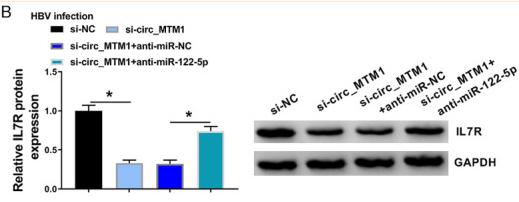IL7R Antibody - #DF6362
| Product: | IL7R Antibody |
| Catalog: | DF6362 |
| Description: | Rabbit polyclonal antibody to IL7R |
| Application: | WB IHC IF/ICC |
| Cited expt.: | WB, IHC |
| Reactivity: | Human, Mouse, Rat |
| Mol.Wt.: | 52~80kDa; 52kD(Calculated). |
| Uniprot: | P16871 |
| RRID: | AB_2838326 |
Related Downloads
Protocols
Product Info
*The optimal dilutions should be determined by the end user. For optimal experimental results, antibody reuse is not recommended.
*Tips:
WB: For western blot detection of denatured protein samples. IHC: For immunohistochemical detection of paraffin sections (IHC-p) or frozen sections (IHC-f) of tissue samples. IF/ICC: For immunofluorescence detection of cell samples. ELISA(peptide): For ELISA detection of antigenic peptide.
Cite Format: Affinity Biosciences Cat# DF6362, RRID:AB_2838326.
Fold/Unfold
CD 127; CD127; CD127 antigen; CDw127; IL 7R alpha; IL 7R; IL-7 receptor subunit alpha; IL-7R subunit alpha; IL-7R-alpha; IL-7RA; IL7R; IL7RA; IL7RA_HUMAN; IL7Ralpha; ILRA; Interleukin 7 receptor alpha chain; Interleukin 7 receptor; Interleukin 7 receptor isoform H5 6; Interleukin-7 receptor subunit alpha;
Immunogens
A synthesized peptide derived from human IL7R, corresponding to a region within N-terminal amino acids.
- P16871 IL7RA_HUMAN:
- Protein BLAST With
- NCBI/
- ExPASy/
- Uniprot
MTILGTTFGMVFSLLQVVSGESGYAQNGDLEDAELDDYSFSCYSQLEVNGSQHSLTCAFEDPDVNITNLEFEICGALVEVKCLNFRKLQEIYFIETKKFLLIGKSNICVKVGEKSLTCKKIDLTTIVKPEAPFDLSVVYREGANDFVVTFNTSHLQKKYVKVLMHDVAYRQEKDENKWTHVNLSSTKLTLLQRKLQPAAMYEIKVRSIPDHYFKGFWSEWSPSYYFRTPEINNSSGEMDPILLTISILSFFSVALLVILACVLWKKRIKPIVWPSLPDHKKTLEHLCKKPRKNLNVSFNPESFLDCQIHRVDDIQARDEVEGFLQDTFPQQLEESEKQRLGGDVQSPNCPSEDVVITPESFGRDSSLTCLAGNVSACDAPILSSSRSLDCRESGKNGPHVYQDLLLSLGTTNSTLPPPFSLQSGILTLNPVAQGQPILTSLGSNQEEAYVTMSSFYQNQ
Research Backgrounds
Receptor for interleukin-7. Also acts as a receptor for thymic stromal lymphopoietin (TSLP).
N-glycosylated IL-7Ralpha binds IL7 300-fold more tightly than the unglycosylated form.
Cell membrane>Single-pass type I membrane protein.
Cell membrane>Single-pass type I membrane protein.
Secreted.
The WSXWS motif appears to be necessary for proper protein folding and thereby efficient intracellular transport and cell-surface receptor binding.
The box 1 motif is required for JAK interaction and/or activation.
Belongs to the type I cytokine receptor family. Type 4 subfamily.
Research Fields
· Environmental Information Processing > Signaling molecules and interaction > Cytokine-cytokine receptor interaction. (View pathway)
· Environmental Information Processing > Signal transduction > FoxO signaling pathway. (View pathway)
· Environmental Information Processing > Signal transduction > PI3K-Akt signaling pathway. (View pathway)
· Environmental Information Processing > Signal transduction > Jak-STAT signaling pathway. (View pathway)
· Human Diseases > Cancers: Overview > Pathways in cancer. (View pathway)
· Human Diseases > Immune diseases > Primary immunodeficiency.
· Organismal Systems > Immune system > Hematopoietic cell lineage. (View pathway)
References
Application: WB Species: Human Sample: LX-2 cells
Application: IHC Species: human Sample:
Restrictive clause
Affinity Biosciences tests all products strictly. Citations are provided as a resource for additional applications that have not been validated by Affinity Biosciences. Please choose the appropriate format for each application and consult Materials and Methods sections for additional details about the use of any product in these publications.
For Research Use Only.
Not for use in diagnostic or therapeutic procedures. Not for resale. Not for distribution without written consent. Affinity Biosciences will not be held responsible for patent infringement or other violations that may occur with the use of our products. Affinity Biosciences, Affinity Biosciences Logo and all other trademarks are the property of Affinity Biosciences LTD.

